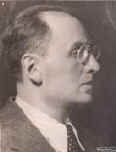|
Aldo
Finzi was born in Milan on February 4, 1897 into an old Jewish
family that originally came from Mantua. The family had a traditional love
for music and Finzi’s aunt was a celebrated soprano by the name of
Giuseppina Finzi Magrini. After completing his classical studies at the
Liceo Parini in Milan, he took a degree in law at the university in Pavia
and simultaneously took his diploma in compositions as a private student at
the Conservatoire of Santa Cecilia in Rome. Finzi soon gained success and
celebrity among the young Italian composers. His works include lyrics, music
“da camera,” symphonic music and the dramatic work, Shylock
(unfinished), which was inspired by the anti-Jewish persecutions.
|
 Aldo
Finz
Aldo
Finz |
In 1931, Finzi’s
published works listed in Ricordi’s catalogue included: Il
Chiostro
(The Cloister) for female voices and orchestra, the symphonic poems,
Cirano de Bergerac, and Inni alla notte (Hymns to the
night), a sonata for violin and piano, a quartet for
strings, various lyrics like Barque d’or and a comic opera,
La Serenata al Vento, which is based on a libretto written by
Veneziani. His most important works include a symphonic poem,
L’infinito, written in 1933, a concerto for piano and orchestra,
Interludio, written in 1934, and the symphonic poem, Nunquam,
Sinfonia Romana, of 1937.
In 1937 the Scala Theatre announced a competition for a new opera to
be performed during the following season. Aldo Finzi entered the
competition with his work, La Serenata al Vento. Riccardo
Pick-Mangiagalli, an older colleague to Finzi and a member of the
jury informally advised Finzi ahead of the official announcement,
that he had won the competition. However, the official letter,
expected in the spring of 1938, never arrived. The reason given was
that none of the works entered were considered worthy of being
performed. Finzi realized that the judgement made in his favour, had
been annulled by the intervention of the government and that he had
been victim of the official anti-Semitism at the time.
During the Nazi occupation that followed, Finzi went into hiding, working
anonymously or under an assumed name. For example, Finzi’s rhythmic
translation to Italian of Béatitudes by Franck, is published under
another name. In 1944 he wrote, under his own name, Preludio e fuga per
Organo (Prelude and fugue for organ) and to express gratefulness to God
for having brought him and his son unscathed through the war, he wrote a
Salmo per
coro
e orchestra
(Psalm for chorus and orchestra) in 1944-45. Aldo Finzi informed his son
Bruno that the Psalm was dedicated to the Conservatory of Tel Aviv. The
stress of having to escape from one place to another and his imprisonment -
miraculously avoiding the mass deportations and house searching - altogether
undermined his health and he died of a heart attack on February 7, 1945.
Following Finzi’s death, his music lay undiscovered until recently. Only now
performers and scholars have access to his output, a totally unique corpus
in comparison to the Italian music of the period and only now can his heirs
actually realise Finzi’s last wish, whispered to his beloved relatives on
his deathbed “Let my music be performed”.
|